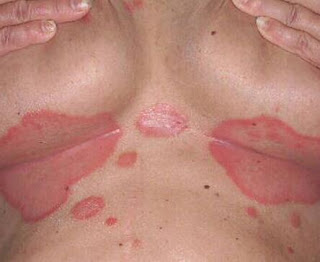Inverse psoriasis is a rare form of psoriasis that affects between 3% and 7%
of the patients with psoriasis. It can comprise genital skin folds as part of
genital psoriasis, and it is one of the most commonly seen dermatoses of this
area. There are few evidence-based studies about the treatment of intertriginous
psoriasis involving genital skin folds.
Psoriasis in general is a genetic condition passed down through families. The
immune system causes the skin to begin producing too many new skin cells,
spurring skin cell turnover. While psoriasis is genetic in nature, researchers
believe some environmental factor triggers it. In the case of inverse psoriasis,
the triggers are friction and dampness, associated with sweating.
Inverse psoriasis occurs in 2 to 6 percent of people with psoriasis and most
often alongside some other type of psoriasis, such as plaque psoriasis. It is
more common in people who are overweight or obese or have deep skin folds.
People who are middle-aged or seniors are more likely to contract flexural
psoriasis than younger people.
Inverse Psoriasis Onset and Symptoms
The first signs of inverse psoriasis are very deep red patches of skin in
body folds. These lesions tend to be shiny and smooth — the moistness of the
affected area prevents the development of the dry skin scales that accompany
other types of psoriasis.
Inverse psoriasis can be one of the most painful and irritating forms of the
disease, due to the location of the lesions around the genitals and armpits and
underneath the breasts and buttocks. The affected skin becomes very tender and
is further irritated by sweating and skin rubbing against itself. Sometimes a
crease in the center of an inverse psoriasis lesion will crack open, creating
the possibility of bleeding or infection.
Inverse Psoriasis Treatment
For treating it properly it is must to treat both the problems i.e. the yeast
infection with the help of yeast infection pill or yeast infection cream and
inverse psoriasis can also be treated with many available inverse psoriasis
treatments.
The affected skin is extremely sensitive which can create difficulty for
treating the inverse psoriasis. There is no doubt that steroids ointments and
creams are more effective but still sufferer can’t use steroid occlusive
dressings because it can develop more moisture. The excessive use of steroid
cream can make the skin thin as well as too much stretching marks in the skin
can also occur. As skin in inverse psoriasis is already thin so after using
steroid cream for longer period of time it becomes even thinner. Along with the
antifungal cream diluted topical steroids can be taken like 1-2 percent
hydrocortisone cream.
Light therapy. UVB rays can help soothe psoriasis symptoms. You can get it
either through sunlight or light therapy with sun lamps, but either way it must
be under your doctor's supervision.
Systemic medications. People with severe inverse psoriasis may need to take
pills or receive injections to help treat their symptoms. Options include
immunosuppressive medicines like methotrexate and cyclosporine, or biologic
drugs that target specific immune reactions.

No comments:
Post a Comment